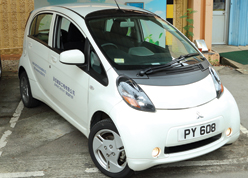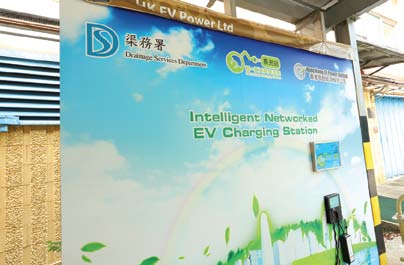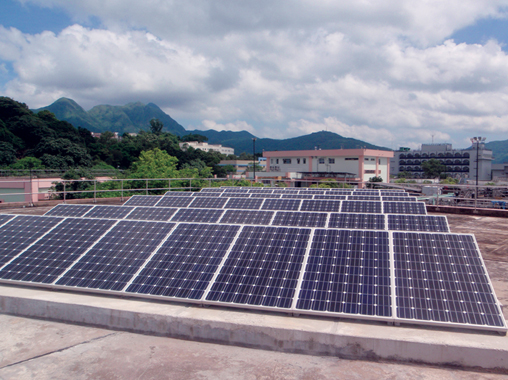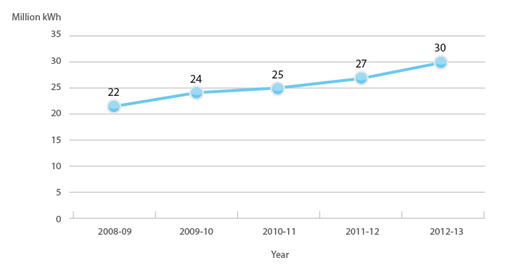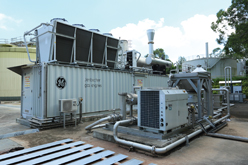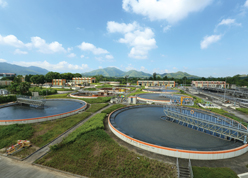Energy Management and Emission Control
Conducting Carbon Audit
Carbon audit is a method to identify, account and report on the emission and removal of Greenhouse Gas(GHG), mainly carbon dioxide(CO2), from different processes within the boundary of the entity. Carbon audit enables us to identify the major sources of emission and find ways to reduce them through reduction in consumption, improvement in efficiency, use of renewable energy etc.
We conducted the first carbon audits for Tai Po STW and Stonecutters Island STW in 2012. The audit results revealed that about 9,207 and 36,733 tonnes of CO2 equivalent were emitted respectively from these two plants in 2011. In terms of carbon intensity, it is about 0.27 and 0.074 kilogram of CO2 equivalent emitted per cubic metre of sewage treated.
We continued to conduct carbon audits for Shatin STW and Shek Wu Hui STW during the year. The results showed that about 25,489 and 7,167 tonnes of CO2 equivalent were emitted in 2011 respectively from these two plants, which represents 0.31 and 0.24 kilogram CO2 equivalent emitted per cubic metre of sewage treated.
Looking forward, DSD will conduct carbon audits and adopt carbon emission reduction measures at more of its STWs and construction works with a view to reducing DSD's carbon footprint, making it more environmentally friendly while also providing high quality drainage and sewage treatment services to the public.
Carbon Footprint in 2011 (in tonnes of CO2 equivalent)
| Name of plant | Total emission | Indirect emissions generated from the use of electricity | N2O emissions(in tonnes of CO2 equivalent) through nitrogen removal | Emissions generated from direct combustion of fuels | Others |
|---|---|---|---|---|---|
| Shatin STW | 25,489 | 19,374 | 782 | 5,171 | 162 |
| Tai Po STW | 9,207 | 8,722 | 368 | 43 | 74 |
| Shek Wu Hui STW | 7,167 | 6,777 | 377 | 1 | 12 |
| Stonecutters Island STW | 36,733 | 36,196 | 0 | 4 | 533 |
Use of Electric Vehicle
To support the latest development of green transportation and sustainable development of Hong Kong, we have taken every opportunity to promote the use of electric vehicle(EV). As EV is powered by batteries without involving any combustion process, its greatest advantage is producing zero emissions and helping improve roadside air quality in Hong Kong. At present, there are eight EVs in our fleet. The total average daily mileage delivered by our EVs was about 600 kilometres per day as at March 2013. With more experience accumulated in the application of EVs, we target to promote a wider use of EVs in our projects.
Implementing Various Energy Saving Measures
Our Department has made steady progress in saving energy and reducing emission in its city-wide operation subsequent to the formation of the Energy and Emission Management Team in 2007. The team, headed by an Assistant Director and with representatives from all branches at the senior professional level, came into being shortly after the Chief Executive of HKSAR signed the Clean Air Charter in November 2006.
We have managed to save more than 11 million kilowatt-hour (kWh) electricity over the last five years. This is achieved with the implementation of measures including the optimisation of sewage treatment processes, the use of combined heat and power (CHP) plants at various sewage treatment works, the replacing of T8 fluorescent lamps and outdoor lights with T5 lamps and LED respectively at various plants, as well as the use of high-efficiency pump motors in our treatment facilities. The largest contributors to energy saving in 2012-13 were the co-settling and optimisation of sludge treatment processes at Shatin STW and the utilisation of biogas for the CHP plants at Shek Wu Hui STW.
Use of Renewable Energy
Use of photovoltaic solar panels in sewage treatment facilities
We have implemented different large-scale stand alone or grid-connected photovoltaic (PV) systems supplying electricity to part of the equipment at our various major facilities, e.g. Yuen Long STW, Shek Wu Hui STW, Sandy Bay PTW, Stonecutter Islands STW, etc. The total capacity and annual electricity output of the PV panels were about 88 kilowatt (kW) and 96,000 kWh per year respectively at these plants. In the coming two years, we are going to install PV panels in five other sewage treatment facilities with a total capacity of 39 kW.
Currently, most of our PV systems are installed at the roofs of our sewage treatment facilities. In order to explore more flexible applications of PV systems and to save the roof spaces for other uses, we are carrying out a pilot study on the application of vertical type Building Integrated Photovoltaic (BIPV) system. We will install a vertical type BIPV system at Shatin STW to investigate the system's performance and efficiency with different solar cell materials (i.e. Mono-crystallite silicon, Poly-crystalline silicon and Amorphous silicon). It is anticipated that the proposed vertical type BIPV system will not only allow better space utilisation, but will also bring around 1,750 kWh annual saving in electricity and reduce around one tonne of CO2 equivalent per year. This pilot study will provide useful reference for our future applications of vertical type BIPV system in our various facilities.
Electricity Generated from Biogas
Turning Waste Gas to Energy
Taking note that biogas from anaerobic digestion of sludge generated from sewage treatment is a renewable energy source, we looked into a better way to utilise the biogas generated including installation of combined heat and power (CHP) generators and Micro-Turbine in our plants in the past decade. CHP generator and Micro-Turbine system are to obtain energy from a single fuel (for instance biogas) by means of combustion, where heat and power are generated simultaneously, thus improving the overall energy efficiency. CHP generator and Micro-Turbine fueled by biogas primarily is considered to be a cleaner technology with lower carbon emission. We are installing new CHP generators (with a combined capacity of 2.03 megawatts) in Shatin and Tai Po STWs, and Micro-Turbine (capacity of 30 kW) in Yuen Long STW. Together with other recently installed CHP generators at Tai Po STW (commissioned in 2010 and with the capacity of 625 kW) and at Shek Wu Hui STW (commissioned in 2011 and with the capacity of 635 kW), we foresee a full utilisation of all biogas generated from our sewage treatment works in 2013. We recorded an increasing trend in the electricity generated in five consecutive years and the amount of electricity generated from biogas in 2012-13 went up to about 30 million kWh.








